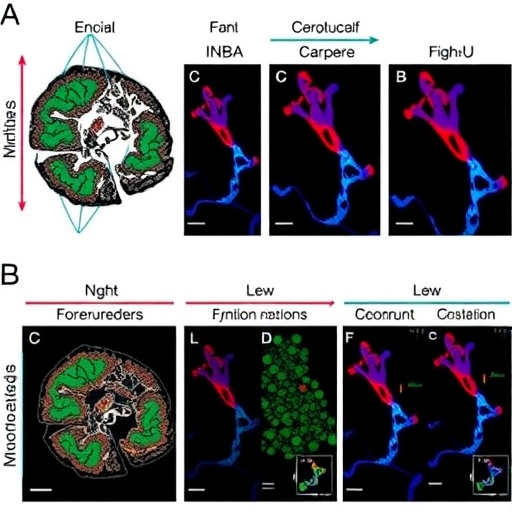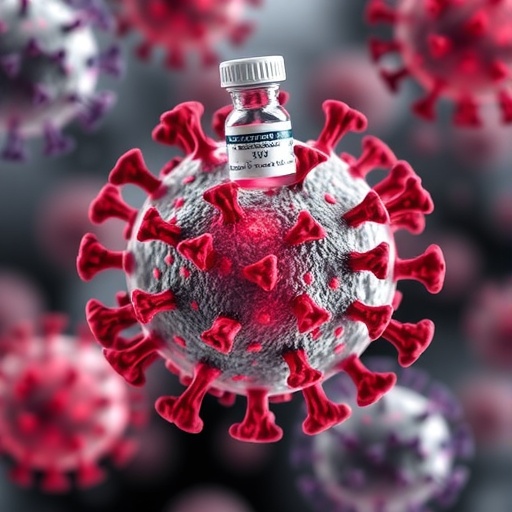
In a groundbreaking study poised to reshape our understanding of oral squamous cell carcinoma (OSCC), researchers have uncovered a distinctive immunosuppressive tumor microenvironment linked to submucous fibrosis-derived cases. This discovery highlights how unique subsets of immune and stromal cells, specifically INHBA-positive macrophages and pro-inflammatory cancer-associated fibroblasts (CAFs), orchestrate a tumor milieu that may hinder the effectiveness of immunotherapy for patients suffering from this aggressive cancer form.
Oral submucous fibrosis (OSF), a potentially malignant disorder frequently linked to areca nut chewing, predisposes patients to a particular subtype of OSCC known as ODSCC (oral squamous cell carcinoma derived from OSF). This particular lineage of cancer cells appears to create a more hostile and immune-evasive microenvironment, setting it apart from OSCCs without OSF history (termed NODSCC). While previous studies have evaluated the molecular and metabolic landscapes of ODSCC, the precise cellular players driving the immunosuppressive network remained elusive until now.
Employing state-of-the-art single-cell RNA sequencing (scRNA-seq) coupled with spatial transcriptomics (ST) techniques, Zhao and colleagues performed a deep dissection of the tumor microenvironment (TME) in ODSCC. By analyzing publicly available GEO database datasets alongside multiple immunofluorescence staining, they delineated the complex cellular crosstalk that supports tumor progression and immune evasion. Their findings indicate a pivotal elevation of exhausted CD8+ T cells and regulatory T cells (Tregs), which suppress effective anti-tumor immunity, paired with a marked reduction in cytotoxic T lymphocytes — the frontline soldiers of tumor eradication.
A critical discovery within this study is the enrichment of macrophages expressing Inhibin subunit beta A (INHBA), termed INHBA+ macrophages, which are prominently elevated in ODSCC compared to NODSCC. These macrophages display the strongest immune suppressive signatures, including heightened immune checkpoint molecule activity, diminished major histocompatibility complex (MHC) expression, and increased levels of SPP1, a marker closely associated with tumor-promoting functions. Importantly, INHBA+ macrophages sourced from ODSCC exhibit more pronounced immunosuppressive properties than those from NODSCC, suggesting a microenvironment finely tuned to thwart immune surveillance.
Alongside these macrophages, the study identified proinflammatory cancer-associated fibroblasts (iCAFs) as another major contributor to the unique tumor ecology of ODSCC. These iCAFs express higher levels of INHBA, while also being enriched in pathways related to immune modulation and extracellular matrix remodeling. Crucially, iCAFs in ODSCC express genes like TDO2, IDO1, and DUSP4 at significantly elevated levels compared to NODSCC. These genes are implicated in creating an immunosuppressive microenvironment through the catabolism of tryptophan and immune signaling regulation, collectively dampening the immune system’s ability to attack tumor cells effectively.
The researchers also spotlighted how INHBA expression is not only prevalent within immune and stromal cells but can be induced by arecoline, a principal alkaloid found in areca nuts frequently chewed in regions endemic to OSF. In vitro experiments utilizing THP-1 macrophage-like cells demonstrated that arecoline stimulation dramatically increases INHBA expression. This result bridges a direct causative link between lifestyle risk factors and molecular changes underpinning tumor immune evasion.
Integration of spatial transcriptomics revealed a localized co-distribution of INHBA+ macrophages, iCAFs, and Tregs within the TME. This physical proximity suggests that these cell subsets engage in intimate paracrine interactions that sculpt an immunosuppressive niche. Further computational analyses pinpointed specific molecular interactions involving INHBA and its receptors ACVR1, ACVR2A, and ACVR2B in regions where these immune and stromal cells converge, inferring a potential signaling axis modulating Treg differentiation and functional activity.
From a translational perspective, the heightened presence of INHBA+ macrophages and iCAFs in ODSCC likely manifests as a more severe tumor immunosuppressive microenvironment (TISME), which could explain why patients with this subtype show poorer responses to immune checkpoint blockade therapies. This insight not only emphasizes the need to customize immunotherapy regimens considering tumor origin and microenvironment but also identifies INHBA and its associated signaling pathways as promising therapeutic targets.
The comprehensive multi-omics approach deployed in this study underscores the necessity of understanding tumor biology at a single-cell resolution, particularly within spatial contexts. By navigating the complex heterogeneity of tumor-infiltrating immune and stromal cells, the researchers have illuminated a heretofore unappreciated architectural framework of the ODSCC microenvironment that confers immune privilege and supports cancer progression.
Outside of immune evasion, the enhanced expression of collagen and extracellular matrix components orchestrated by iCAFs suggests these fibroblasts also contribute to the physical remodeling of the tumor niche, which may further impede immune cell infiltration. This combination of biochemical and biomechanical immunosuppressive modalities paints a sophisticated portrait of tumor-host interactions in OSF-related OSCC.
Furthermore, the coupling of environmental exposure (arecoline) to molecular shifts within the TME highlights the multifaceted drivers of tumor evolution in specific populations. This offers crucial insights for preventative interventions aimed at diminishing OSF incidence, potentially reducing subsequent malignancies with refractory immune microenvironments.
Beyond its immediate clinical relevance, the study opens new avenues for mechanistic exploration of TGF-β family signaling, given INHBA’s role as a member of this superfamily. Understanding how INHBA-ACVR receptor complexes specifically modulate immune cell phenotypes may reveal novel checkpoints for modulating immunosuppression that can be pharmacologically exploited in OSCC and other solid tumors.
In summary, this pioneering research delineates a richly detailed immune-stromal landscape in ODSCC defined by INHBA+ macrophages and pro-inflammatory CAFs that foster a uniquely suppressive microenvironment. The findings not only deepen comprehension of OSF-derived OSCC pathobiology but also carry impactful translational implications for biomarker development and rational design of combination therapies targeting the immunosuppressive network.
As immunotherapy continues to transform oncology, studies like Zhao et al.’s serve as a reminder that the microenvironment’s cellular choreography can decisively influence treatment outcomes. By unraveling the complexity of tumor-immune crosstalk in OSF-related cancers, science edges closer to therapies tailored to surmount immune escape and improve prognosis for patients burdened by this challenging disease.
—
Subject of Research: Distinctive immunosuppressive tumor microenvironment in submucous fibrosis-derived oral squamous cell carcinoma characterized by INHBA-positive macrophages and pro-inflammatory cancer-associated fibroblasts.
Article Title: INHBA+ macrophages and Pro-inflammatory CAFs are associated with distinctive immunosuppressive tumor microenvironment in submucous Fibrosis-Derived oral squamous cell carcinoma
Article References:
Zhao, S., Zhang, Y., Meng, X. et al. INHBA+ macrophages and Pro-inflammatory CAFs are associated with distinctive immunosuppressive tumor microenvironment in submucous Fibrosis-Derived oral squamous cell carcinoma. BMC Cancer 25, 857 (2025). https://doi.org/10.1186/s12885-025-14261-2
Image Credits: Scienmag.com
DOI: https://doi.org/10.1186/s12885-025-14261-2
Tags: Areca nut chewing and cancercancer-associated fibroblasts rolecellular crosstalk in tumorsImmune Evasion Mechanismsimmunosuppressive tumor microenvironmentINHBA-positive macrophagesODSCC subtype analysisoral squamous cell carcinoma immunotherapyoral submucous fibrosis cancersingle-cell RNA sequencing in cancerspatial transcriptomics in oncologytumor microenvironment characterization





